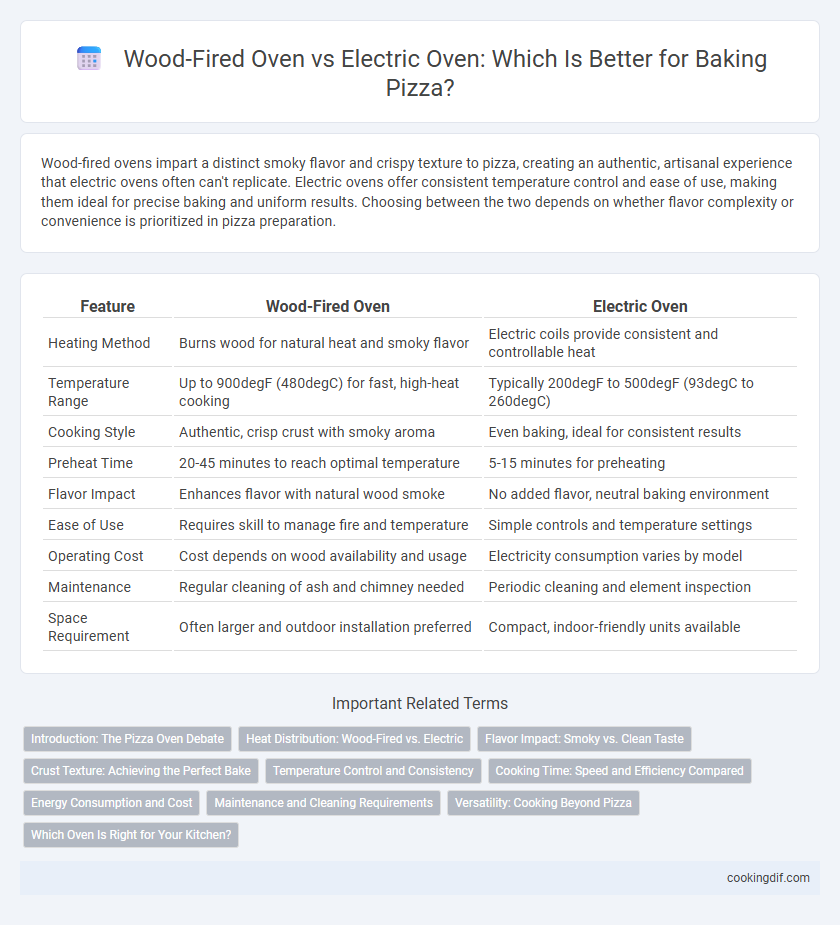Wood-fired ovens impart a distinct smoky flavor and crispy texture to pizza, creating an authentic, artisanal experience that electric ovens often can't replicate. Electric ovens offer consistent temperature control and ease of use, making them ideal for precise baking and uniform results. Choosing between the two depends on whether flavor complexity or convenience is prioritized in pizza preparation.
Table of Comparison
| Feature | Wood-Fired Oven | Electric Oven |
|---|---|---|
| Heating Method | Burns wood for natural heat and smoky flavor | Electric coils provide consistent and controllable heat |
| Temperature Range | Up to 900degF (480degC) for fast, high-heat cooking | Typically 200degF to 500degF (93degC to 260degC) |
| Cooking Style | Authentic, crisp crust with smoky aroma | Even baking, ideal for consistent results |
| Preheat Time | 20-45 minutes to reach optimal temperature | 5-15 minutes for preheating |
| Flavor Impact | Enhances flavor with natural wood smoke | No added flavor, neutral baking environment |
| Ease of Use | Requires skill to manage fire and temperature | Simple controls and temperature settings |
| Operating Cost | Cost depends on wood availability and usage | Electricity consumption varies by model |
| Maintenance | Regular cleaning of ash and chimney needed | Periodic cleaning and element inspection |
| Space Requirement | Often larger and outdoor installation preferred | Compact, indoor-friendly units available |
Introduction: The Pizza Oven Debate
Wood-fired ovens reach temperatures of 700 to 900 degrees Fahrenheit, creating crispy crusts with a distinctive smoky flavor that electric ovens struggle to replicate. Electric ovens offer precise temperature control and consistent heat distribution, making them ideal for baking pizza in indoor settings. The choice between wood-fired and electric ovens ultimately influences the texture, flavor, and cooking time of the pizza.
Heat Distribution: Wood-Fired vs. Electric
Wood-fired ovens provide superior heat distribution by radiating intense, consistent heat from the dome and stone floor, creating the signature crispy crust and evenly cooked toppings essential for authentic pizza. Electric ovens rely on heating elements and fans, which can produce less uniform heat, sometimes resulting in unevenly baked pizzas with hotspots or undercooked areas. The natural airflow and high thermal mass of wood-fired ovens ensure balanced heat circulation that enhances texture and flavor in every slice.
Flavor Impact: Smoky vs. Clean Taste
Wood-fired ovens impart a distinctive smoky flavor to pizza, enhancing its aroma and creating a rustic taste profile that electric ovens typically cannot replicate. The high, uneven heat of wood-fired cooking produces a charred, crispy crust with deeper flavor complexities. Electric ovens deliver a cleaner, more consistent bake, preserving the natural flavors of the toppings without adding smoky undertones.
Crust Texture: Achieving the Perfect Bake
Wood-fired ovens reach temperatures of 700 to 900 degrees Fahrenheit, producing a crispy, charred crust with a smoky aroma and uneven bubbles that enhance texture complexity. Electric ovens typically operate at lower temperatures, around 450 to 500 degrees Fahrenheit, resulting in a more uniform, less blistered crust with a softer interior. The intense heat and radiant flames of wood-fired ovens create a unique Maillard reaction that is difficult to replicate in electric ovens, making them ideal for achieving the signature Neapolitan-style pizza crust.
Temperature Control and Consistency
Wood-fired ovens provide intense, uneven heat reaching up to 900degF, enhancing pizza flavor but requiring skillful management for consistent cooking. Electric ovens offer precise temperature control with consistent heat distribution, ensuring uniform pizza baking and easier reproducibility. Optimal pizza results depend on balancing the traditional taste from wood-fired ovens with the reliable consistency of electric ovens.
Cooking Time: Speed and Efficiency Compared
Wood-fired ovens reach temperatures of 800degF to 900degF, allowing pizzas to cook in just 90 seconds to 2 minutes, offering unparalleled speed and producing a crisp, charred crust. Electric ovens typically operate at lower temperatures, around 500degF to 600degF, resulting in longer cooking times of 8 to 12 minutes and a more uniform but less smoky flavor. The faster heat retention and intense direct flame in wood-fired ovens contribute to higher cooking efficiency for traditional Neapolitan-style pizzas.
Energy Consumption and Cost
Wood-fired ovens consume renewable biomass, offering lower operational costs but require more time and skill to maintain consistent temperatures. Electric ovens provide precise temperature control with higher energy efficiency, yet electricity costs can lead to greater long-term expenses. Choosing between them depends on balancing initial investment, fuel availability, and desired cooking style.
Maintenance and Cleaning Requirements
Wood-fired ovens require regular removal of ash and soot buildup, demanding thorough cleaning to maintain optimal heat retention and flavor profiles. Electric ovens offer easier maintenance with removable racks and smooth surfaces that simplify cleaning, reducing labor and detergent use. Consistent upkeep of wood-fired ovens prevents creosote buildup, while electric ovens benefit from self-cleaning functions to minimize residue.
Versatility: Cooking Beyond Pizza
Wood-fired ovens offer exceptional versatility, allowing cooking of a wide range of dishes such as roasted vegetables, baked bread, and grilled meats with a distinct smoky flavor. Electric ovens provide precise temperature control, making them ideal for consistent baking of diverse recipes like casseroles, cookies, and roasted dishes. The choice depends on whether flavor complexity or cooking precision is prioritized for culinary versatility beyond pizza.
Which Oven Is Right for Your Kitchen?
Wood-fired ovens produce high, consistent heat around 800degF, creating a crispy crust and smoky flavor ideal for authentic Neapolitan-style pizza, while electric ovens offer precise temperature control and convenience suited for home kitchens or small pizzerias. Wood-fired ovens require ample space, ventilation, and maintenance, making them better for commercial or outdoor setups, whereas electric ovens are compact, easy to operate, and compatible with various kitchen layouts. Choosing the right oven depends on your kitchen size, desired pizza style, and whether you prioritize traditional flavor or operational efficiency.
Wood-fired oven vs electric oven for baking Infographic

 cookingdif.com
cookingdif.com